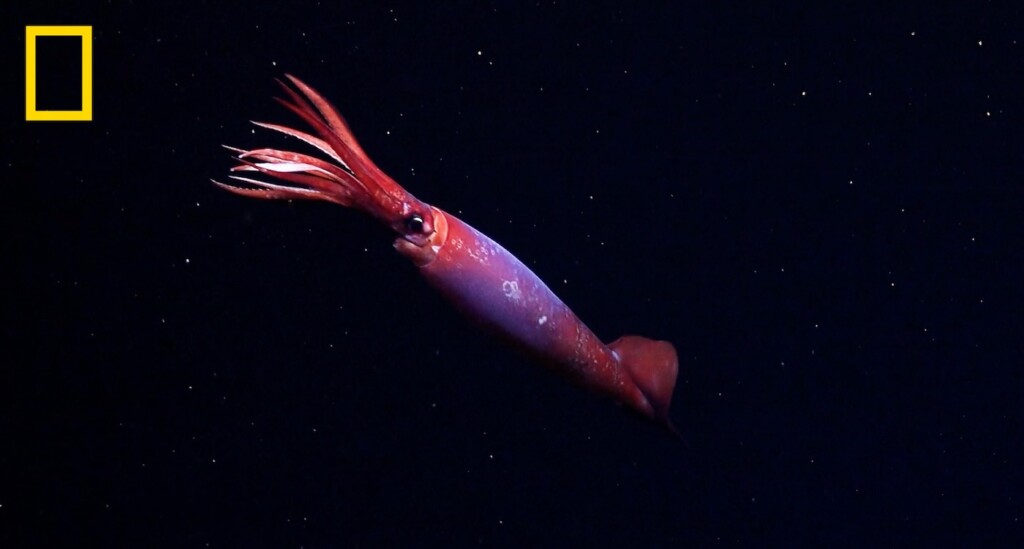 First-known sighting of living Antarctic squid Gonatus antarcticus, spotted by researchers on the National Geographic and Rolex Perpetual Planet Expedition in the Southern Ocean – Credit: ROV SuBastian / Schmidt Ocean Institute
First-known sighting of living Antarctic squid Gonatus antarcticus, spotted by researchers on the National Geographic and Rolex Perpetual Planet Expedition in the Southern Ocean – Credit: ROV SuBastian / Schmidt Ocean InstituteResearchers have recorded a video sighting of a three-foot-long deep-sea squid species that’s never been filmed nor seen alive.
Gonatus antarcticus squid, an elusive squid found only in the frigid waters around Antarctica, was discovered on Christmas Day by the Schmidt Ocean Institute’s research vessel, the R/V Falkor (too), in a surprise moment caught on camera via the research vessel’s remotely operated vehicle, SuBastian.
Prior to the astonishing discovery, the species was only known from carcasses in fishing nets or when the squids’ beaks were found in the stomach of fished marine animals.
Footage of the squid shows the animal with scratches on its arms and fresh-looking sucker marks on its mantle but otherwise shows it is in good shape. Spotted at a depth of approximately 2,152 meters—below 6,000 feet—in the Weddell Sea, researchers have not been able to confirm the squid’s sex from the footage, nor age, but the discovery is a reminder of how much more there is to learn about the relatively unexplored polar regions of our world’s ocean.
Undertaken through the National Geographic and Rolex Perpetual Planet Expedition in the Southern Ocean, the footage will be broadcast in an upcoming National Geographic documentary, and more can be read about this amazing encounter and animal on the Nat Geo website.
According to squid expert Dr. Kathrin Bolstad, who worked with marine biologist and expedition team member Manuel Novillo on the species identification, the large single central hook observed on each tentacle club clinched her confirmation that the squid was the elusive Gonatus antarcticus.
It belongs to the family Gonatidae, which contains 19 species across three genera. Known as armhook squids after the central hook spotted by Bolstad,
The research team also mapped several previously unexplored sites throughout the Southern Ocean, including depths that reached 10,000 feet, obtaining various samples of sediment, water, and biota to study the health of various Southern Ocean habitats, including abyssal plains, hydrothermal vents, troughs, canyon walls and sea ice.
This work was conducted aboard the Falkor in collaboration with the Schmidt Ocean Institute, which provided National Geographic Explorers the opportunity to leverage its state-of-the-art tools and capabilities during its maiden voyage to the Southern Ocean.
ALSO CHECK OUT: Thar’ Be a Kraken! First Video Footage of a Possible Colossal Squid in its Own Habitat Captured
Though not as large as the giant squid or colossal squid, three feet is a significant size under the pressures of life 3,000 meters below sea level.
GNN reported recently that the colossal squid had been filmed for the first time when a juvenile drifted past the cameras on the same Schmidt Ocean Institute vessel earlier this year. Dr. Bolstad was also consulted to identify the creature.
DEEP-SEA DELIGHT: Thriving Ecosystem of Deep-Sea Creatures Discovered After Iceberg Detached Serendipitously from Antarctica
“We’re finally seeing confirmed footage of this animal that some of us have been studying and dreaming about for decades,” said Dr. Bolstad at the time. “The spots on the mantle [the tube-like body] tells us that it almost certainly can switch back and forth between being completely transparent… to being quite opaque.”
Unlike the colossal squid, however, this armhook squid was an adult, meaning much more can be learned about it.
SHARE This Amazing Deep-Sea Discovery With Your Friends On Social Media…
Source link

